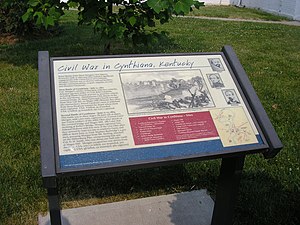Battle of Cynthiana
The Second Battle of Cynthiana included three separate engagements during the American Civil War that were fought on June 11 and 12, 1864, in Harrison County, Kentucky, in and near the town of Cynthiana. This was part of Confederate Brigadier General John Hunt Morgan's 1864 Raid into Kentucky. The battle ultimately resulted in a victory by Union forces over the raiders and ended Morgan's Last Kentucky Raid in defeat. Morgan's Raiders had previously captured the town in the First Battle of Cynthiana, July 17, 1862.
At dawn on June 11, 1864, Brig. Gen. John H. Morgan approached Cynthiana with 1,200 cavalrymen. The town was defended by a small Union force under Col. Conrad Garis, commanding a detachment of the 168th Ohio Infantry and some home guard troops, about 300 men altogether. Morgan divided his troops into three columns, surrounded the town, and launched an attack at the covered bridge, driving Garis' forces back towards the depot and north along the railroad. The Confederates set fire to the town, destroying many buildings and killing some of the Union troops.
As the fighting flared in Cynthiana, another Union force, about 750 men of the 171st Ohio Infantry under the command of Brig. Gen. Edward Hobson, arrived by train about a mile north of the Cynthiana at Keller's Bridge. This regiment fought Morgan's force for about six hours. Eventually Morgan trapped this new Union force in a meander of the Licking River. Altogether, Morgan had about 1,300 Union prisoners of war camping with him overnight in line of battle. The 171st Ohio Infantry was paroled the next day. This engagement, Morgan's last victory, was known as the Battle of Keller's Bridge [bridge named for Abraham Keller, not spelled "Kellar"].
With little ammunition, Morgan recklessly decided to stay and fight an expected larger Union force. Brig. Gen. Stephen G. Burbridge with 2,400 men, a combined force of Ohio, Kentucky, and Michigan mounted infantry and cavalry, attacked Morgan at dawn on June 12. The Union forces drove the Rebels back, causing them to flee into town, where many were captured or killed. General Morgan and many of his officers escaped. Combined casualties in the separate Union forces were 1,092 men, while Morgan is estimated to have lost about 1,000 men, although no firm records exist.
...
Wikipedia

